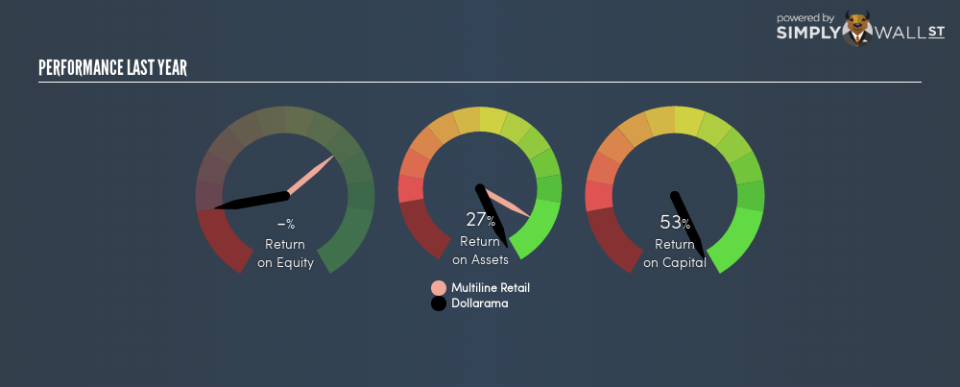A Close Look At Dollarama Inc.’s (TSE:DOL) 53% ROCE

Today we’ll look at Dollarama Inc. (TSE:DOL) and reflect on its potential as an investment. Specifically, we’ll consider its Return On Capital Employed (ROCE), since that will give us an insight into how efficiently the business can generate profits from the capital it requires.
First, we’ll go over how we calculate ROCE. Then we’ll compare its ROCE to similar companies. Finally, we’ll look at how its current liabilities affect its ROCE.
Return On Capital Employed (ROCE): What is it?
ROCE is a measure of a company’s yearly pre-tax profit (its return), relative to the capital employed in the business. All else being equal, a better business will have a higher ROCE. In brief, it is a useful tool, but it is not without drawbacks. Renowned investment researcher Michael Mauboussin has suggested that a high ROCE can indicate that ‘one dollar invested in the company generates value of more than one dollar’.
So, How Do We Calculate ROCE?
Analysts use this formula to calculate return on capital employed:
Return on Capital Employed = Earnings Before Interest and Tax (EBIT) ÷ (Total Assets – Current Liabilities)
Or for Dollarama:
0.53 = CA$756m ÷ (CA$2.1b – CA$641m) (Based on the trailing twelve months to October 2018.)
So, Dollarama has an ROCE of 53%.
Check out our latest analysis for Dollarama
Want to help shape the future of investing tools? Participate in a short research study and receive a subscription valued at $60.
Does Dollarama Have A Good ROCE?
ROCE is commonly used for comparing the performance of similar businesses. In our analysis, Dollarama’s ROCE is meaningfully higher than the 15% average in the Multiline Retail industry. We would consider this a positive, as it suggests it is using capital more effectively than other similar companies. Putting aside its position relative to its industry for now, in absolute terms, Dollarama’s ROCE is currently very good.
In our analysis, Dollarama’s ROCE appears to be 53%, compared to 3 years ago, when its ROCE was 32%. This makes us think about whether the company has been reinvesting shrewdly.
Remember that this metric is backwards looking – it shows what has happened in the past, and does not accurately predict the future. ROCE can be misleading for companies in cyclical industries, with returns looking impressive during the boom times, but very weak during the busts. ROCE is only a point-in-time measure. Future performance is what matters, and you can see analyst predictions in our free report on analyst forecasts for the company.
Dollarama’s Current Liabilities And Their Impact On Its ROCE
Current liabilities are short term bills and invoices that need to be paid in 12 months or less. Due to the way ROCE is calculated, a high level of current liabilities makes a company look as though it has less capital employed, and thus can (sometimes unfairly) boost the ROCE. To check the impact of this, we calculate if a company has high current liabilities relative to its total assets.
Dollarama has total assets of CA$2.1b and current liabilities of CA$641m. Therefore its current liabilities are equivalent to approximately 30% of its total assets. A minimal amount of current liabilities limits the impact on ROCE.
What We Can Learn From Dollarama’s ROCE
Low current liabilities and high ROCE is a good combination, making Dollarama look quite interesting. Of course, you might find a fantastic investment by looking at a few good candidates. So take a peek at this free list of companies with modest (or no) debt, trading on a P/E below 20.
If you like to buy stocks alongside management, then you might just love this free list of companies. (Hint: insiders have been buying them).
To help readers see past the short term volatility of the financial market, we aim to bring you a long-term focused research analysis purely driven by fundamental data. Note that our analysis does not factor in the latest price-sensitive company announcements.
The author is an independent contributor and at the time of publication had no position in the stocks mentioned. For errors that warrant correction please contact the editor at editorial-team@simplywallst.com.

 Yahoo Finance
Yahoo Finance 
